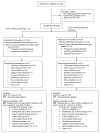Topical chemotherapy in cutaneous T-cell lymphoma: positive results of a randomized, controlled, multicenter trial testing the efficacy and safety of a novel mechlorethamine, 0.02%, gel in mycosis fungoides
- PMID: 23069814
- PMCID: PMC3662469
- DOI: 10.1001/2013.jamadermatol.541
Topical chemotherapy in cutaneous T-cell lymphoma: positive results of a randomized, controlled, multicenter trial testing the efficacy and safety of a novel mechlorethamine, 0.02%, gel in mycosis fungoides
Abstract
Objective: To evaluate the efficacy and safety of a novel mechlorethamine hydrochloride, 0.02%, gel in mycosis fungoides. DESIGN Randomized, controlled, observer-blinded, multicenter trial comparing mechlorethamine, 0.02%, gel with mechlorethamine, 0.02%, compounded ointment. Mechlorethamine was applied once daily for up to 12 months. Tumor response and adverse events were assessed every month between months 1 and 6 and every 2 months between months 7 and 12. Serum drug levels were evaluated in a subset of patients.
Setting: Academic medical or cancer centers.
Patients: In total, 260 patients with stage IA to IIA mycosis fungoides who had not used topical mechlorethamine within 2 years and were naive to prior use of topical carmustine therapy.
Main outcome measures: Response rates of all the patients based on a primary clinical end point (Composite Assessment of Index Lesion Severity) and secondary clinical end points (Modified Severity-Weighted Assessment Tool and time-to-response analyses).
Results: Response rates for mechlorethamine gel vs ointment were 58.5% vs 47.7% by the Composite Assessment of Index Lesion Severity and 46.9% vs 46.2% by the Modified Severity-Weighted Assessment Tool. By the Composite Assessment of Index Lesion Severity, the ratio of gel response rate to ointment response rate was 1.23 (95% CI, 0.97-1.55), which met the prespecified criterion for noninferiority. Time-to-response analyses demonstrated superiority of mechlorethamine gel to ointment (P< .01). No drug-related serious adverse events were seen. Approximately 20.3% of enrolled patients in the gel treatment arm and 17.3% of enrolled patients in the ointment treatment arm withdrew because of drug-related skin irritation. No systemic absorption of the study medication was detected.
Conclusion: The use of a novel mechlorethamine, 0.02%, gel in the treatment of patients with mycosis fungoides is effective and safe.
Trial registration: clinicaltrials.gov Identifier:NCT00168064.
Figures




References
-
- Goodman L, Wintrobe M, Dameshek W, Goodman M, Gilman A, McLennan M. Nitrogen Mustard Therapy: use of methyl-bis (beta-chloroethyl) amine hydrochloride and tris (beta-chloroethyl) amine hydrochloride for Hodgkin’s disease, lymphosarcoma, leukemia and certain allied and miscellaneous disorders. JAMA. 1946;132:126–132. - PubMed
-
- Bunn P, Hoffman S, Norris D, Golitz L, Aeling J. Systemic therapy of cutaneous T-cell lymphoma (mycosis fungoides and the Sezary syndrome) Ann Intern Med. 1994;121(8):592–602. - PubMed
-
- Haserick J, Richardson J, Grant D. Remission of lesions in mycosis fungoides following topical application on nitrogen mustard. Cleve Clin Q. 1959;26:144–147. - PubMed
-
- Sipos K. Painting Treatment of Nitrogen Mustard in Mycosis Fungoides. Dermatologica. 1965;130:3–11. - PubMed
-
- Ramsay DL, Meller JA, Zackheim HS. Topical treatment of early cutaneous T-cell lymphoma. Hematol Oncol Clin North Am. 1995;9(5):1031–1056. - PubMed
Publication types
MeSH terms
Substances
Associated data
Grants and funding
LinkOut - more resources
Full Text Sources
Other Literature Sources
Medical
Miscellaneous

